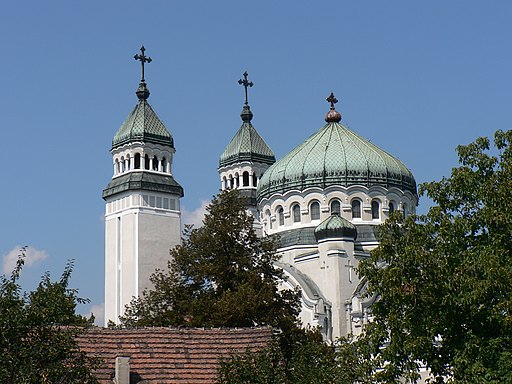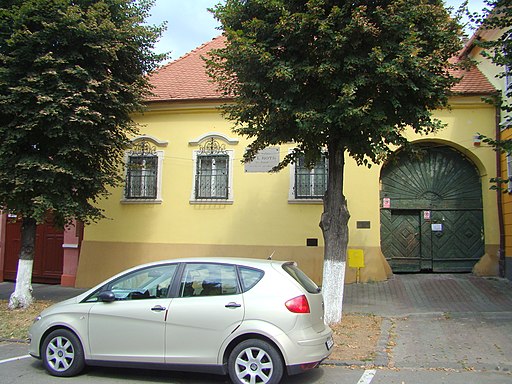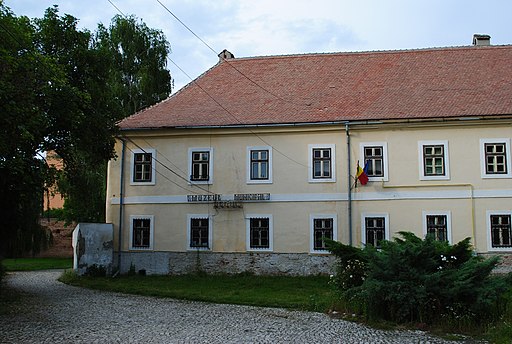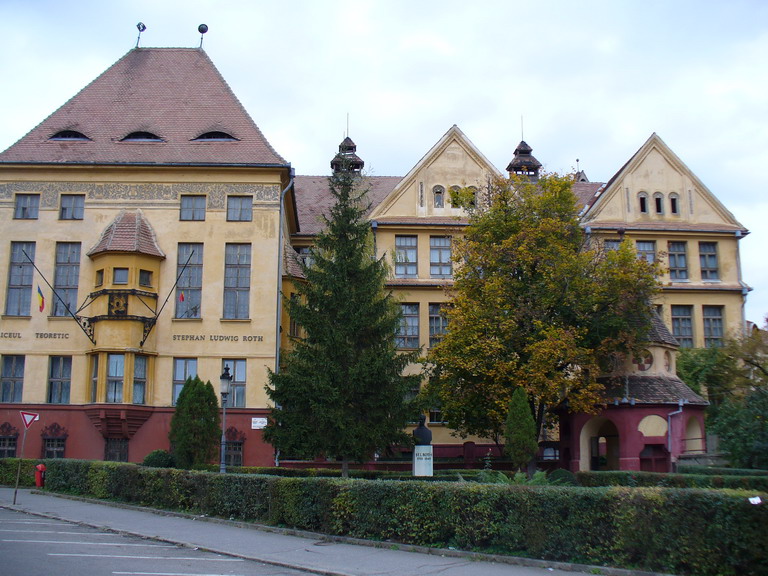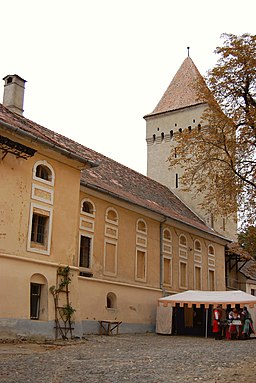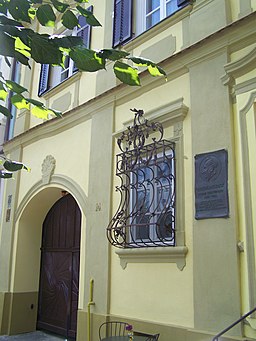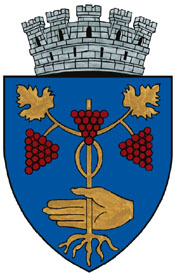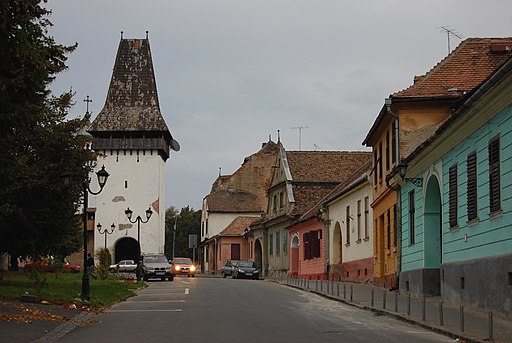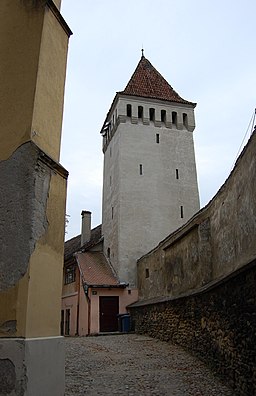895
Arrival of the Hungarians
Little more...
895
The alliance of the seven Hungarian tribes took possession of the then largely uninhabited Carpathian Basin. Until then, the sparse Slavic population of the north-western Carpathians had lived under Moravian rule for a few decades after the collapse of the Avar Khaganate in the early 9th century.
1000
Foundation of the Hungarian Kingdom
Little more...
1000
The Kingdom of Hungary was established with the coronation of King Stephen I. He converted the Hungarians to Christianity and created two archdioceses (Esztergom and Kalocsa) and ten dioceses. He divided Hungary into counties led by ispáns, who were appointed by the king.
1075
King László I of Hungary settled Székelys along the Nagy-Küküllő River, they founded the village on the site of the present day Medgyes, which got its name from them. The village was situated northeast of the inner castle, where the Langgasse (str. Petru Rareș), the Pfarhofgasse (str. Bisericii) and the Zekesch Street (str. Mihai Viteazul) are now located. Its cemetery was found under the Lutheran church.
after 1130
King Géza II of Hungary gradually relocated the Székelys to the eastern, uninhabited borderlands of Transylvania (to the present day Székelyföld).
1141-1161
During the reign of King Géza II of Hungary, German, Flemish and in smaller numbers also Walloon settlers arrived in southern Transylvania. The settlers probably came after the second crusade crossed Hungary in 1147. People who couldn’t count on inheriting land in their homeland came from the territory of the dioceses of Cologne and Trier. They were granted new home in Hungary on lands that had recently become desolate after the Székely border guards living there had been relocated to the area of Háromszék by order of the king. These settlers were later called collectively Saxons, which does not mean that they came from Saxony.
1146
According to the tradition, the settlement was founded in 1146, which makes Medgyes one of the oldest towns of Transylvania. King Géza II of Hungary settled Saxons in place of the Székelys.
1224
King Andrew II of Hungary issued the Andreanum, the golden charter of freedoms of the Transylvanian Saxons (goldener Freibrief). This recognized the Saxons as collective legal entity, removed them from the jurisdiction of the royal ispáns (the leaders of the counties), and placed the newly appointed ispán of Szeben over them. The territory inhabited by the Saxons became their own property, and they were legally equal. If the owner of the land died without inheritors, the property reverted to the community and not the king. The Saxons elected their own superiors and priests. Their leader, the ispán of Szeben, also called Count of the Saxons (comes Saxonum), was appointed by the king, but after 1486 they could choose the count themselves. Saxons were allowed to hold fairs and trade freely. Their land was called King's Land (Királyföld, Fundus Regius, Königsboden). Saxons had the most rights in Hungary, they were actually exempted from feudalism.
1241-1242
Mongol Invasion
Little more...
1241-1242
The hordes of the Mongol Empire invaded Hungary and almost completely destroyed it. One third to one half of the population was destroyed. The Mongols also suffered heavy losses in the battle of Muhi and they could not hunt down the king. After their withdrawal, King Béla IV reorganized Hungary. He allowed the feudal lords to build stone castles because they were able to successfully resist the nomadic Mongols. The vast majority of stone castles were built after this. The king called in German, Vlach (Romanian) and Slavic settlers to replace the destroyed population.
July 3, 1267
The settlement was already inhabited by Saxons. The settlement was mentioned for the first time as Mediesy. Its name comes from the Hungarian meggy word meaning sour cherry. The German name comes from the Hungarian name.
1283
The settlement was the seat of a deaconry. It was called Villa Medjes.
1301
The extinction of the House of Árpád
Little more...
1301
The House of Árpád, the first Hungarian royal dynasty, died out with the death of King Andrew III. Hungary was ruled by oligarchs, the most powerful of whom was Csák Máté, whose main ally was the Aba family. King Charles I (1308-1342), supported by the Pope, eventually emerged as the most prominent of the contenders for the Hungarian throne. But it took decades to break the power of the oligarchs.
1315
King Charles I of Hungary placed the inhabitants of Medgyes, Selyk and Berethalom under the authority of the ispán (comes) of Szeben.
1317
The fairs of the settlement were mentioned for the first time.
1318
The Seat of Medgyes (Medgyesszék) was mentioned for the first time. Seats were the special administrative units of the Saxons. Medgyes was the centre of the seat. King Charles I of Hungary granted privileges to the inhabitants of Medgyes and Nagyselyk and exempted them from the duty of serving in the royal army. Taxation and justice were administered according the common law of Szeben. The parish school was established in the 14th century. Ramparts and moats protected the settlement at that time.
early 14th century
Walls and two towers were constructed around the St. Margaret church as a defence. The walls were raised and fortified with three bastions and a moat due to the Turkish threat in the 15th century. This fortification was mentioned for the first time in 1450.
1359
The settlement was called Civitas Megyes, which meant that it was a town. Later it was called oppidum (a serf town with some privileges) again.
1402
King Sigismund of Hungary exempted the Saxons of Medgyes and Selyk from the jurisdiction of the ispán of the Székelys, so the two Saxon seats became independent.
1411
The expression ’Two seats’ was used for the first time.
until the 16th century
The settlement was mentioned as an oppidum most of the time and it rivalled Nagyselyk and Berethalom until 1552.
1414
The St. Margaret church, the first church of the settlement, was completed.
1424
King Sigismund granted the town right to hold two country fairs annually.
1437
The three nations of Transylvania (the Hungarian nobility, the Székelys and the Saxons) formed an alliance in Kápolna (Union of Kápolna). This union gained its true significance after 1570, when Transylvania became an independent principality due to the Turkish conquest of central Hungary. These three nations were represented in the Transylvanian Diet, and they elected the prince. Vlach migrants (mostly shepherds and peasants) were a small minority at the time and were excluded from the political power just like Hungarian peasants. According to the agreement, the Saxon fortified churches were opened for the non-Saxon population of the neighbourhood as well in times of danger. This was a great concession, because only Saxons (and not even Hungarian nobles) could acquire land and purchase house in King's Land. Only Saxon monks could live in their monasteries and Saxons were strictly forbidden by their priests to adopt Hungarian customs, dress and hairstyle. The Transylvanian Saxons were never integrated into the Hungarian community that welcomed them and gave them so many privileges, and they never had any inclination to do so.
1438
Turkish raiders sacked the settlement, which decimated its population. Sultan Murad II sent an army of raiders against Hungary under the command of Bey Ali. The Turks were aided by the Vlach army of Voivode Vlad Drakul of Wallachia. They crossed the Danube at Szörény Castle. They captured Medgyes with an assault, but Szeben resisted the siege. Finally, they burned the outskirts of Brassó and left Hungary through the Törcsvár Pass.
1444
Franciscan monks settled in Medgyes. They built a monastery, their church was built after 1500.
1450
The castellan of the town’s fortification was mentioned for the first time.
1457
The tailor’s and clothmaker’s guild was mentioned for the first time.
1459
The country assembly of Hungary gathered in Medgyes for the first time.
1462, 1467
King Matthias of Hungary visited Medgyes, which was an oppidum at that time.
1476
Vlad Dracula (Vlad Tepes) was held captive in the Marienturm (Mary’s Tower) in Medgyes by order of King Matthias of Hungary. In 1476, Vlad Tepes took back the throne of Wallachia with the help of the Hungarian army of vajda Báthory István of Transylvania, but as he couldn’t gain enough support in his homeland, the Turks killed him, when the Hungarian army left Wallachia.
1477
King Matthias obliged the town to send 32 soldiers in times of war.
1486
King Matthias of Hungary confirmed the autonomy of the Saxons. The Transylvanian Saxon Universality (universitas saxonum) was established, which was the official body of self-governance of the Saxons. It had administrative, legislative and judicial powers and was only subordinate to the King of Hungary. Saxons could only be judged by the Saxon Universality. It had the right to elect the Count of the Saxons from among the 12 members of the town council of Nagyszeben. The official language of the Saxon Universality was German, while the official language of Hungary was Latin.
1486
King Matthias of Hungary ordered Medgyes to build defensive walls. The walls of the town were built between 1490 and 1534 with a length of 2360 metres.
1487
The town’s hospital was mentioned for the first time.
between 1490 and 1532
The town walls were constructed by order of King Matthias of Hungary against the Turkish threat. The walls limited the growth of the town until the 18th century.
from 1495
Medgyes was mentioned as town (cicitas) more and more frequently.
from 1507
An annual fair was held on 13 July on the feast of St. Margaret.
1510
Three hundred Saxon settlers, 38 landless serfs, two shepherds and four poor men lived in Medgyes together with their families.
1526
Battle of Mohács and the splitting of Hungary into two parts
Little more...
1526
Sultan Suleiman I launched a war against Vienna, instigated by the French. Ferdinand I, Duke of Austria, was the brother-in-law of King Louis II of Hungary. The army of the Ottoman Empire defeated the much smaller Hungarian army at Mohács, and King Louis II died in the battle. A group of the barons elected Ferdinand I of the House of Habsburg to the throne, who promised to defend Hungary from the Turks. He was the younger brother of the most powerful European monarch Emperor Charles V. But the nobility chose the most powerful Hungarian baron, Szapolyai János, who was also crowned as King John I. The country was split in two and a decades-long struggle for power began.
1528
King John I suffered a decisive defeat on 20 March in the battle of Szina and fled to Poland. Ferdinand I was crowned King of Hungary and he took control of Transylvania as well. After King John I was let down by his French and Polish allies, he asked the Sultan for help. In 1529, the Turks launched a campaign and captured Buda, the capitol of Hungary, and handed it over to King John I, whom they recognized as King of Hungary.
1529
Kun Kocsárd, the commander of the Székely army, besieged Medgyes on behalf of King John I. The town that supported King Ferdinand I finally surrendered in August 1530.
1534
King John I granted Medgyes a privilege, which prohibited the trading of foreign goods in the town except for the yearly fairs.
September 1534
Lodovico Gritti, the governor of Hungary, fled to Medgyes from the armies of vajda Majláth István of Transylvania, King John I of Hungary and the voivode of Wallachia. Voivode Peter of Moldova sent in his aid also joined the besiegers. The besiegers broke into the town after the walls were breached by cannons. Gritti fled to the Moldavian camp, but they handed him over to the Hungarians. He was beheaded in the castle of Medgyes on 29 September by order of vajda Majláth István. Gritti was a Venetian soldier of fortune, who arrived in Hungary in 1529 as a minion of the Turks. He soon convinced King John I to name him governor of Hungary. It was out of the ordinary, because governors were only appointed in Hungary when the king was under age. Gritti, who was only interested in forging his own fortune, held a court that diminished even the royal court. Gradually everyone turned against him, which was only made worse by his plundering and that he even tried to make a deal with King Ferdinand I. The last drop in the glass (a Hungarian saying) was that Dóczi Orbán killed Bishop Czibak Imre of Várad, one of the greatest supporters of King John I, by order of Governor Gritti. This made the nobility of Transylvania rise up under the leadership of vajda Majláth István.
1537
King John I summoned the burghers of Medgyes, because they obstructed the trade of the burghers of Brassó.
1539
King John I confirmed the right of the merchants of Medgyes to buy and sell goods freely in the entire territory of Hungary.
1541
The Turkish occupation of the capital, Buda, and the division of Hungary into three parts
Little more...
1541
The Turks conquered Buda, the capital of Hungary, after the death of King John I. The central part of the country was under Turkish rule for 150 years. The western and northern parts (including present-day Slovakia) formed the Kingdom of Hungary ruled by the Habsburg emperors. The eastern parts (now mainly under Romanian rule) were ruled by the successors of King John I of Hungary, who later established the Principality of Transylvania.
May 17, 1545
The synod of the Saxon priest of Transylvania decided on joining the Lutheran faith in Medgyes. The parish school of the town also became Lutheran. The altar and the frescoes of the church were removed.
1551
The child John Sigismund's guardian, George Martinuzzi, with Castaldo's imperial army, forced Queen Isabella to surrender the Eastern Hungarian Kingdom (including Transylvania) to King Ferdinand I. Isabella left for Poland with her child, the heir to the throne. The Turks then launched a punitive campaign against Hungary.
1552
King Ferdinand granted Medgyes free royal town status. The seats of Medgyes and Nagyselyk were united under the name ’Two seats’ (Kétszék) and Medgyes became its permanent centre. Medgyes won the economic rivalry between the oppidums of the neighbourhood and it became the centre of the Saxon inhabited lands and also the wine region along the Küküllő River.
1556
The Estates of Transylvania, dissatisfied with Habsburg rule, recalled Queen Isabella to the throne, to which the Sultan gave his consent. On her return, she regained control of eastern Hungary.
around 1556
The Franciscan monks were driven out of Medgyes. Their church was taken from them, and their monastery was used as a stable.
1557
The leprosy hospital of the town was mentioned. Plague decimated the population in the years 1586, 1601–1604, 1633, 1646, 1653, 1656–1658, 1660–1661 and 1717–1718.
1561
The Lutheran synod accepted the Augsburg Confession.
1564
A great fire devastated the town.
1566
Giovanandrea Gromo, the captain of the bodyguard of King John II, visited the town after the devastations of a plague. Most of the houses were in ruins at that time. Most of the houses were built from stone, but there were still a lot of wooden buildings.
1570
The establishment of the Principality of Transylvania
Little more...
1570
John II (John Sigismund), the son of King John I of Hungary, renounced the title of King of Hungary in favor of King Maximilian of the House of Habsburg, and henceforth held the title of Prince. This formally created the Principality of Transylvania, which was the eastern half of Hungary not ruled by the Habsburgs and was also a vassal of the Ottoman Empire. John II died in 1571, after which the three nations of Transylvania (the Hungarian nobility, the Székelys and the Saxons) elected the prince.
16–17th century
Country assembly was held in Medgyes several times.
May 25, 1571
After the death of Prince John II (John Sigismund), the mostly Protestant Transylvanian estates elected the Roman Catholic aristocrat Báthory István as Prince of Transylvania. But King Maximilian I (Emperor Maximilian II) couldn’t make do with the fact that the estates of Transylvania were free to elect their own prince. The king convinced the Unitarian aristocrat Bekes Gáspár to rebel against Prince Báthory István with false promises.
1573
The country assembly of Transylvania gathered in Medgyes authorized Prince Báthory István to eliminate the faction led by Bekes Gáspár.
July 8, 1575
In the Battle of Kerelőszentpál, the Habsburg-backed Bekes Gáspár suffered a final defeat at the hands of Prince Báthory István, which secured the independence of the Principality of Transylvania from the Habsburg Empire.
January 28, 1576
The Polish emissaries asked Prince Báthory István to be King of Poland at the country assembly in Medgyes. The country assembly confirmed Báthory as Prince of Transylvania, who left his younger brother Kristóf behind as governor in Transylvania.
1586
The town’s school was mentioned for the first time (Schola civitatis).
1588
The country assembly gathered in Medgyes decided on expelling the Jesuits from Transylvania and proclaimed Báthory Zsigmond, the son of Kristóf, to be of age and elected him Prince of Transylvania.
1591-1606
Fifteen Years' War
Little more...
1591-1606
The Ottoman Empire started a war against the Habsburg Empire. The war was waged in the territory of Hungary. The Turks defeated the combined armies of the Habsburg Empire and the Principality of Transylvania in the battle of Mezőkeresztes in 1596, but their victory was not decisive. The war devastated the Principality of Transylvania, which was occupied by the Habsburg army, and General Basta introduced a reign of terror.
1599
Prince Báthory Zsigmond renounced the throne again in favour of the brother of Boldizsár, Cardinal Báthory András. Báthory András wanted to place Transylvania under Turkish patronage again, but he was accepted neither by the Saxons nor by the Székelys and he could gain the support of neither the Habsburgs nor the Turks.
1599
Bishop Báthory András was elected Prince of Transylvania here, after Báthory Zsigmond abdicated.
1602
The country assembly in Medgyes protested against General Basta’s reign of terror.
May-July, 1603
The army of Székely Mózes captured the town. Székely Mózes liberated Transylvania from the imperial occupation with his Székely and Turkish troops in the absence of General Basta in 1603. Székely Mózes was elected prince by the country assembly on 9 May. He was the only Székely prince of Transylvania. The Habsburgs mobilized their vassal, Voivode Radu Serban of Wallachia, who attacked the camp of Székely Mózes at night at Brassó on 17 July. The Prince was killed and General Basta returned to Transylvania.
1604-1606
Uprising of Bocskai István
Little more...
1604-1606
The alliance of the Habsburgs and the Principality of Transylvania was defeated by the Ottoman Empire in the Fifteen Years' War. The war devastated Transylvania, which was occupied by the Habsburg imperial army, and General Basta introduced a reign of terror. The nobility and the burghers were upset about the terror, the plundering mercenaries and the violent Counter-Reformation. Bocskai István decided to lead their uprising after the Habsburg emperor tried to confiscate his estates. Bocskai also rallied the hajdú warriors to his side. He was elected Prince of Transylvania and soon liberated the Kingdom of Hungary from the Habsburgs. In 1605 Bocskai István was crowned King of Hungary with the crown he received from the Turks.
August 27, 1605
Bocskai István marched into Medgyes solemnly. He was elected Prince of Transylvania here on 14 September. He was already elected on 21 February in Marosszerda, but without the consent of the Saxons.
23 June 1606
Peace of Vienna
Little more...
23 June 1606
Bocski István made peace with Emperor Rudolf. Their agreement secured the constitutional rights of the Estates of Hungary, and the freedom of religion. The counties of Szatmár, Bereg and Ugocsa were annexed to the Principality of Transylvania. Bocskai died of illness in the same year, leaving to his successors the idea of unifying Hungary from Transylvania.
December, 1610
Prince Báthory Gábor of Transylvania launched a campaign for the throne of Wallachia, which was the vassal of the Habsburgs at that time. Voivode Radu Serban fled, and Báthory captured his capitol, Targoviste, without any resistance. He wanted to gain the consent of the Turks by saying that his campaign was part of the preparation for the conquest of Poland, but the Turks didn't give their consent.
1611
Weiss Mihály, Judge of Brassó, denied the entrance to the town for Prince Báthory Gábor of Transylvania. Instead, he turned to Radu Serban, the former voivode of Wallachia removed by Báthory, for help. Radu crossed the mountains with his mercenaries and took Báthory by surprise at Szentpéter on 8 July. The Prince retreated to Szeben. Radu besieged Szeben and Forgách Zsigmond, the captain of Kassa, hurried to his aid without the approval of the nádor of Hungary. Báthory was saved by the army of Pasha Omer of Bosnia, from which both Radu and Forgách also fled.
1611
The imperial forces under the command of Captain Forgách Zsigmond occupied Medgyes, but they were driven out by the army of Prince Báthory Gábor the same year. The Prince demanded a tribute of 12 thousand forints from the town.
1612
Prince Báthory Gábor tried to convince the Estates of Transylvania to join the Habsburgs, but they did not want to agree. Ghéczy András gained the support of the Turks against Báthory.
October 15, 1612
Prince Báthory Gábor of Transylvania defeated the combined armies of Ghéczy András and the Saxons of Brassó. Judge Weiss Mihály was also killed in the battle. The decisive battle was fought on the plain of Földvár, when the mercenaries of Weiss Mihály, Judge of Brassó, ran away and the soldiers of Prince Báthori Gábor slaughtered most of the remaining Saxon students. The judge was also killed in his flight and his head put on display in the Saxon town of Nagyszeben.
1613
Instead of the violently ruling and immoral Báthory Gábor, the Transylvanian estates elected Bethlen Gábor, who was supported by the Turks, as their prince. At that time, the fallen prince was staying in Várad, and was willing to hand over the most important border fortress of Transylvania to the Turks just to keep the throne, but the hajdú warriors hired by Ghéczy András murdered him on 27 October, 1613.
March 5, 1614
The murderers of Prince Báthory Gábor, Szilasi János and Nadányi Gergely, were caught and executed at the country assembly in Medgyes.
1616
The town hall was mentioned for the first time.
1619
The campaign of Prince Bethlen Gábor of Transylvania in the Thirty Years' War
Little more...
1619
At the beginning of the Thirty Years' War (1618-1648), Prince Bethlen Gábor of Transylvania went to war against the Habsburg emperor as an ally of the rebelling Czech-Moravian-Austrian estates. The whole Kingdom of Hungary joined him, only the Austrian defenders of Pozsony had to be put to the sword. With his allies, he laid siege to Vienna. However, he was forced to abandon the siege because the Habsburg-loyal Hungarian aristocrat Homonnai Drugeth György attacked his heartland with Polish mercenaries. On 25 August 1620, the Diet of Besztercebánya elected Bethlen Gábor King of Hungary as vassal of the Turks. He continued to fight after the defeat of the Czechs at White Mountain on 8 November 1620, but without real chance to achieve decisive victory, he decided to come to an agreement with Emperor Ferdinand II.
31 December 1621
Peace of Nikolsburg
Little more...
31 December 1621
Prince Bethlen Gábor of Transylvania made peace with Emperor Ferdinand II. Their agreement secured the constitutional rights of the Estates of Hungary, and later it was supplemented with the freedom of religion. Bethlen renounced the title of King of Hungary in exchange for seven counties of the Upper Tisza region (Szabolcs, Szatmár, Bereg, Ugocsa, Zemplén, Borsod, Abaúj) for the rest of his life, other estates in Hungary as his private property and the imperial title of Duke of Oppeln and Ratibor (Opole and Racibórz), one of the Duchies of Silesia. Prince Bethlen went to war against the Habsburgs in 1623 and 1626, but was unable to negotiate more favourable terms.
after 1637
The Lutheran school was expanded to a grammar school. The classes of Philosophy and Theology were opened after 1762.
1639
The wooden bridge was built over the Nagy-Küküllő.
1644-1645
The campaign of Prince Rákóczi György I of Transylvania in the Thirty Years' War
Little more...
1644-1645
Prince Rákóczi György I of Transylvania allied with the Swedes and the French in the Thirty Years' War and went to war against the Habsburg Emperor Ferdinand III. On 18 July 1645 his army joined forces with Torstenson's Swedish army under Brno (Moravia). The excellent artillery of Transylvania opened fire on the city walls. However, Rákóczi had to give up the siege, having been informed that the Turks were planning a punitive campaign against Transylvania, because he went to war against the Sultan's prohibition.
16 December 1645
Peace of Linz
Little more...
16 December 1645
Prince Rákóczi György I of Transylvania made peace with Emperor Ferdinand III. It secured the freedom of religion for the Protestants and extended it also to the serfs. Rákóczi received the same seven Hungarian counties that Prince Bethlen Gábor had also held (Abauj, Zemplén, Borsod, Bereg, Ugocsa, Szabolcs, Szatmár) until his death, and the counties of Szabolcs and Szatmár were also to be inherited by his sons. The Rákóczi family also received several new estates.
1657
Prince Rákóczi György II of Transylvania launched a campaign for the crown of Poland in alliance with Carl X Gustaf of Sweden. His aim was to unite the Hungarian-Polish-Wallachian forces against the Turks. The campaign started successfully with the prince taking Kraków and Warsawa, but then the King of Sweden abandoned him. The vengeful Poles invaded northern Transylvania, burning defenceless villages, destroying churches and castles. Soon the punitive campaign of Turkish and Tatar armies devastated Transylvania, as the prince launched his Polish campaign against the Sultan's will.
January 9, 1658
The country assembly dethroned Prince Rákóczi György II in Medgyes, and recognized him as prince again on 24 January.
1683
Turkish defeat at Vienna and the formation of the Holy League
Little more...
1683
The combined armies of the Habsburg Empire and the Kingdom of Poland defeated the Turkish army besieging Vienna. Emperor Leopold I wanted to make peace with the Turks, but was refused by Sultan Mehmed IV. In 1684, at the persistent urging of Pope Innocent XI, the Holy League, an alliance of the Kingdom of Poland, the Habsburg Empire, the Republic of Venice and the Papal States, was formed to expel the Turks from Hungary. Thököly Imre, who had allied himself with the Turks, was gradually driven out of northern Hungary.
1686
Recapture of Buda and the liberation of Hungary from the Turks
Little more...
1686
The army of the Holy League recaptured Buda from the Turks by siege. In 1687, the Imperial army invaded the Principality of Transylvania. The liberation was hindered by the French breaking their promise of peace in 1688 and attacking the Habsburg Empire. By 1699, when the Peace of Karlóca was signed, all of Hungary and Croatia had been liberated from the Ottoman Empire with the exception of Temesköz, the area bounded by the Maros, the Tisza and the Danube rivers. It was not until the Peace of Požarevac in 1718 that Temesköz was liberated from the Turks. However, the continuous war against the Turkish invaders and the Habsburg autocracy, which lasted for more than 150 years, wiped out large areas of the Hungarian population, which had previously made up 80% of the country's population, and was replaced by Vlachs (Romanians), Serbs and other Slavic settlers and Germans. The Habsburgs also favoured the settlement of these foreign peoples over the 'rebellious' Hungarians.
1690
Transylvania became part of the Kingdom of Hungary again, with internal autonomy and freedom of religion
Little more...
1690
According to the Diploma Leopoldinum issued by Emperor Leopold I, Transylvania became part of the Kingdom of Hungary again and Hungarian law remained in force. The three nations (the Hungarians, the Székelys – who are also Hungarians –, and the Saxons) administered its internal affairs with autonomy and the freedom of religion was also preserved. The incorporation of Transylvania into the Habsburg Empire was prevented by the temporary election of Thököly Imre as Prince of Transylvania in 1690 with Turkish help.
from the early 18th century
The Saxon villages that were left desolate by the wars were repopulated by Vlach migrants from Wallachia. Vlachs appeared in the Saxon towns as well. This was the start of the process by the end of which Vlachs were in the majority in Transylvania instead of Hungarians.
1703-1711
Hungarian War of Independence led by Prince Rákóczi Ferenc II
Little more...
1703-1711
After the expulsion of the Turks, the Habsburgs treated Hungary as a newly conquered province and did not respect its constitution. The serfs rose up against the Habsburg ruler because of the sufferings caused by the war and the heavy burdens, and they invited Rákóczi Ferenc II to lead them. Trusting in the help promised by King Louis XIV of France, he accepted. Rákóczi rallied the nobility to his side, and soon most of the country was under his control. The rebels were called the kurucs. In 1704, the French and the Bavarians were defeated at the Battle of Blenheim, depriving the Hungarians of their international allies. The Rusyn, Slovak and Vlach peasants and the Saxons of Szepes supported the fight for freedom, while the Serbs in the south and the Saxons in Transylvania served the Habsburgs. Due to lack of funds Rákóczi could not raise a strong regular army, and in 1710, Hungary was also hit by a severe plague. Rákóczi tried unsuccessfully to forge an alliance with Tsar Peter the Great of Russia. In his absence, without his knowledge, his commander-in-chief, Károlyi Sándor, accepted Emperor Joseph I's peace offer. The Peace of Szatmár formally restored the Hungarian constitution and religious freedom and granted amnesty, but did not ease the burden of serfdom. Rákóczi refused to accept the pardon and went into exile. He died in Rodosto, Turkey.
April 7, 1705
The kuruc army of Count Forgách Simon besieged the town and captured it from the imperials after 10 weeks. The imperials took the town back in November. Shortly after that, the kuruc insurgents returned, and Pekry Lőrinc damaged the walls, then he had some of the walls demolished. The demolished walls were later replaced by weaker brick walls.
October 27, 1706
Prince Rákóczi Ferenc II held a country assembly in Medgyes.
1720
The Franciscan monks returned to their ruinous monastery.
1722
A Roman Catholic school was established. It operated until 1948.
1730s
The town was protected by 19 towers and could be accessed through four smaller and three large gates.
between 1741 and 1789
The Piarists operated a lower grammar school.
1754
Empress Maria Theresia moved the Royal Court of Justice (Tabula Regia), the supreme court of Transylvania, from Medgyes to Marosvásárhely.
between 1767 and 1810
The printing press of Johann Sifft operated in Medgyes.
18th century
New quarters emerged outside of the town walls with Saxon and Vlach population.
1781
The decree of Emperor Joseph II introduced "concivility", which allowed non-Saxons to settle and acquire property in King's Land.
July 4, 1781
The decree of Emperor Joseph II allowed Hungarians and Vlachs to move to the inner town. The emperor wanted to Germanize Hungary, and the official language of Hungary became the German. Austrian officials and military officers were moved to Medgyes. 4568 people lived in the town at that time.
1783
Emperor Joseph II abolished the Transylvanian Saxon Universality and the Saxon seats (traditional administrative units) were incorporated into the new county system. Joseph II, who was never crowned King of Hungary, thus he was called ’the king in hat’, made German the official language of Hungary instead of Latin, which the Saxons protested against together with the Hungarian Estates.
1790
When Emperor Joseph II, the ’enlightened’ absolute ruler of Hungary died, bonfires were lit throughout Transylvania and Hungarians and Saxons celebrated the repeal of his decrees as one. The Transylvanian Saxon Universality was restored, but the "concivility", the decree that allowed non-Saxons to settle in the land of the Saxons was not withdrawn.
1804–5
The military barracks was built south of the town, but a significant garrison had already been stationed in the town before.
early 19th century
Most of the outer ring of walls was demolished and its stones were used for the local constructions. The Lutheran fortified church in the centre was once also surrounded with walls.
1826
The first Vlach church of the town was built owing to the Greek Catholic bishop of Balázsfalva, Ioan Bob. He also opened a Vlach language school.
1840s
Its fair held on the feast of St. Margaret was among the significant fairs of Transylvania.
1844
German became the language of education and legal training started in the Lutheran grammar school.
1848-1849
Hungarian Revolution and War of Independence
Little more...
1848-1849
Following the news of the Paris Revolution on 22 February 1848, the Hungarian liberal opposition led by Kossuth Lajos demanded the abolition of serfdom, the abolition of the tax exemption of the nobility, a parliament elected by the people, and an independent and accountable national government. The revolution that broke out in Pest on 15 March expressed its demands in 12 points, which, in addition to the above mentioned, included the freedom of the press, equality before the law, the release of the political prisoners and the union with Transylvania. A Hungarian government was formed, Batthyány Lajos became prime minister, and on 11 April Emperor Ferdinand V ratified the reform laws. On August 31 the Emperor demanded the repeal of the laws threatening with military intervention. In September the Emperor unleashed the army of Jelacic, Ban of Croatia, on Hungary, but they were defeated by the Hungarians in the Battle of Pákozd on 29 September. An open war began for the independence of Hungary. The Habsburgs incited the nationalities against the Hungarians. The Rusyns, the Slovenes and most of the Slovaks and Germans supported the cause persistently, but the Vlachs (Romanians) and the Serbians turned against the Hungarians. The glorious Spring Campaign in 1849 led by General Görgei Artúr liberated almost all of Hungary. On 1 May 1849, Emperor Franz Joseph, effectively admitting defeat, asked for the help of Tsar Nicholas I of Russia, who sent an intervention army of 200,000 soldiers against Hungary. The resistance became hopeless against the overwhelming enemy forces and on 13 August Görgei Artúr surrendered to the Russians at Világos. Bloody reprisals followed, and on 6 October 1849, 12 generals and a colonel of the Hungarian Revolution, the martyrs of Arad, were executed in Arad. On the same day, Batthyány Lajos, the first Hungarian Prime Minister, was executed by firing squad in Pest. The Habsburgs introduced total authoritarianism in Hungary, but they also failed to fulfil their promises to the nationalities that had betrayed the Hungarians.
1848
The Transylvanian Saxons also voted in favour of the reunion with Hungary. However, during the Hungarian War of Independence, they supported the Habsburgs because of their German national consciousness and their loyalty to the Emperor.
May 29, 1848
The representatives of the Saxon seat voted for the union of Transylvania with Hungary against the instructions. The angry burghers of Medgyes didn’t elect them to the country assembly in Pest. The four thousand soldiers of General Gedeon were stationed in the town in summer.
August 1848
The assembly of the Saxon youth greeted the Imperial Diet of Frankfurt with the leadership of Stephan Ludwig Roth.
January 18, 1849
The Hungarian army of General Bem József marched into Medgyes.
February 9, 1849
Major Zsurmay Lipót took the town back after the imperial counter-attack.
February 15, 1849
The Székely army of Gál Sándor joined General Bem at Medgyes.
March 2, 1849
Czetz repelled the imperial army of General Puchner pushing towards the town.
March 3, 1849
General Bem left the town after a bayonet fight. The Hungarians led by Bem retreated towards Segesvár.
after 1849
After the fall of the Hungarian War of Independence, the Saxons’ reward for supporting the Habsburgs against Hungary was that the Habsburg emperor abolished their autonomy and incorporated King's Land into the new centralized administrative system controlled from Vienna. The Count of the Saxons was removed, the locally elected magistrates were replaced by centrally assigned clerks and the Saxons lost their control over the judicial system as well.
1861
The October Diploma issued by Emperor Franz Joseph eased the absolutism and restored the autonomy of the Saxons. The old administrative system of King's Land was restored and the seat of Szászváros (Szászvárosszék) was resurrected for one and a half decades.
1861
The Hungarian casino was founded.
1863
Steet lighting was introduced with kerosene lamps.
1867
Austro-Hungarian Compromise
Little more...
1867
The Habsburg Empire was weakened by the defeats it suffered in the implementation of Italian and German unity. The Hungarians wanted to return to the reform laws of 1848, but they did not have the strength to do so. Emperor Franz Joseph and the Hungarian opposition, led by Deák Ferenc, finally agreed to restructure the Empire and abolish absolutism. Hungary was given autonomy in its internal affairs, with its own government and parliament, which was essential for the development of its economy and culture. However, foreign and military affairs remained in the hands of the Habsburgs and served their aspiration for becoming a great power. The majority wanted Hungary's independence, but they were excluded from political power.
1871
One of the three Saxon agricultural schools (Ackerbauschule), and in 1873 one of the five apprentice’s schools (Gewerbeschule) was established in Medgyes.
1872
Several Saxon political gatherings took place in Medgyes. The first Sachsentag took place in Medgyes in 1872. Their political program declared in Medgyes accepted the constitutional framework of the Austro-Hungarian Monarchy, but they demanded the maintenance of the autonomy of King's Land and the extension of minority rights.
May 6, 1872
The Hungarian East Railway reached the town on the Nagyvárad-Kolozsvár-Tövis-Brassó line.
Ovtober 11, 1872
The Kiskapus-Nagyszeben railway line was opened.
1876
Public administration was modernized and medieval structures were abolished in Hungary. The autonomy of the Saxons was abolished (as was that of the Hungarian Székelys) and their seats were incorporated into the county system. King's Land had already lost its Saxon homogeneity (which was mainly due to low Saxon fertility) by that time making territorial autonomy redundant.
1876
King's Land was incorporated into the county system of Hungary and Medgyes was attached to Nagy-Küküllő County. It became the seat of a district.
after 1876
The Saxon Universality was transformed into a foundation to foster culture and education.
1881
Samuel Karres established a tannery, which was expanded to a leather factory in 1914.
1885
The Hungarian language state school was established in Medgyes.
from 1887
The phylloxera infection caused great damages to traditional viticulture.
1888
The Stürzer textile factory was established.
from 1890
Several Saxon butchers established small factories manufacturing salami and cold cuts. The one established by Josef Theil in 1895 became the most significant. It employed 28 workers in 1898. It is the precursor of the present day Salconserv factory.
October 20, 1893
The so called Green Saxon movement started in Medgyes. Contrary to the Black Saxons who cooperated with the Hungarian government, they took a stand for more radical minority protection, Saxon-Swabian cooperation and maintaining the relationship with Germany.
1902
The town hospital was built with 32 beds.
1910-1912
The new building of the Stephan Ludwig Roth High School was constructed.
1912
The Ambrosi & Czell wine factory was established. The Rosenauer screw factory was established in 1918. The enamelware factory of Peter Westen was opened in 1921. The rayon factory of Josef Klinger was founded in 1922. The Schembra/Ideal bicycle and stroller factory was opened in 1936. All of the significant factories were owned by Saxons or Hungarians, but the majority of the workers were Vlachs already in 1913. According to a statistics from 1943, 2337 Romanian, 1158 Saxon, 889 Hungarian, 70 Jewish industrial workers were in Medgyes, and 201 belonged to other nationalities.
1914
The Citron and Co leather factory was established.
1914-1918
World War I
Little more...
1914-1918
As part of the Austro-Hungarian Monarchy, Hungary took part in the war on the side of the Central Powers.
1916
On 27 August, Romania declared war on the Austro-Hungarian Monarchy and launched an attack against Hungary. This triggered a huge wave of refugees from Transylvania, as the population feared a repeat of the Romanian ethnic cleansing of 1848-49. The Saxon Arthur Arz von Straussenberg led the defence of Transylvania until the arrival of German reinforcement. Austro-Hungarian and German forces drove the invaders out of the country by mid-October and occupied Bucharest on 6 December. Romania surrendered and signed a peace treaty with the central powers on 7 May 1918 (Treaty of Bucharest).
1917
The 5.5 kilometres long gas pipeline connecting the town with the natural gas field of Bázna was constructed. Natural gas, as a local source of energy, boosted industrial development. The seat of the Hungarian Natural Gas Company (Magyar Földgáz Rt) established in Budapest in 1915 was moved to Medgyes in 1923. Its new office building was built in 1925 next to the train station. The company was taken over by the Romanians shortly.
1918
On 3 November, the Austro-Hungarian Monarchy signed the Armistice of Padua. The already defeated Romania then declared war on Germany on 10 November, just one day before the Germans signed the armistice near Compiègne. The Romanians then launched an offensive against Hungary, which had already unconditionally ceased fighting at the demand of the Entente. Romania was only recognised by the Entente powers as one of the victors of WWI only later.
November 1918 - January 1919
The Czech, Romanian and Serbian occupation of Hungary
Little more...
November 1918 - January 1919
In Hungary, the freemasonic subversion brought the pro-Entente Károlyi Mihály to power. The new government, naively trusting the Entente powers, met all their demands and disbanded the Hungarian military, which rendered the country completely defenseless in the most dire need. Under French and Italian command, Czech, Romanian and Serbian troops invaded large parts of Hungary, where they immediately began the takeover. They fired Hungarian railway workers, officials and teachers, banned the use of the Hungarian language, abolished Hungarian education, and disposed of everything that reminded them of the country's Hungarian past. Hundreds of thousands of Hungarians were forced to leave their homeland, and the forcible assimilation of the remaining Hungarians was begun.
December 16, 1918
The Romanian army invaded the town.
January 8, 1919
In the shadow of Romanian occupation, the assembly of the Saxon delegates in Medgyes accepted the union with Romania with the promise of the restoration of Saxon autonomy. In 1910 only 231,000 Saxons lived in Transylvania. The representatives of Medgyes also accepted the union with Romania.
4 June 1920
Trianon Dictate
Little more...
4 June 1920
Hungary was forced to sign the Treaty of Trianon, although the country was not invited to the peace talks. Hungary lost two thirds of its territory that had belonged to it for more than 1000 years. One-third of the Hungarian population came under foreign rule. On the basis of the national principle, countries with a more mixed and less ethnically balanced composition than the former Hungary were created, such as Czechoslovakia and the Kingdom of Serbs, Croats and Slovenes (later Yugoslavia). For example, while 48% of the population of the territory ceded to Czechoslovakia was Slovak and 30% Hungarian, 54% of the population of the former Hungary was Hungarian and 10.6% Slovak. And in the territory that is now part of Serbia, the Hungarians outnumbered the Serbs. The part of the territory allocated to Romania from Hungary was larger than the remaining territory of Hungary, despite the fact that there were 10 million Hungarians and less than 3 million Romanians in the former Hungary. While Hungary used to have the most liberal nationality policy in Europe, the successor states had no respect at all for the national and cultural rights of the indigenous Hungarians and engaged in forced assimilation. The Trianon Dictate destroyed the organic economic unity of the region. Before the First World War, Hungary had a dynamic economy, more advanced than Spain's. After 1920, the successor states formed the so-called "Little Entente", putting Hungary under an economic blockade and sabotaging it on the international stage.
1922
The Csáki brothers moved the Vitrometan glassworks from Budapest to Medgyes and they recruited German workers from Czechia. They built a residential area for the workers next to the factory. It was the largest glassworks of south-eastern Europe in the 1930s and most of its products were exported. The owner Csáki brothers were arrested in 1949. The factory gave one third of the production of Romania the 1970s.
1923
The Romanian government abolished all what remained of the Saxon autonomy. The vast estates of the Saxon Universality were confiscated, just like the lands of the Hungarian nobility and the historical churches, which almost exclusively financed Hungarian and Saxon education systems in Transylvania. Once again, Saxons were rewarded for betraying Hungary, though it depended by no means on their decision that Transylvania was united with Wallachia and Moldova, which was a decision similar to uniting Switzerland with Nigeria.
until 1941
As a result of the Romanian settlements, the Saxons lost their majority in every town. In desperation, the Saxons joined the SS en masse.
1944
The German high command ordered the evacuation of King's Land, just like East Prussia, but the majority stayed in their homeland. Romania betrayed their allies and sided with the Soviet Union, as soon as the first Soviet forces reached their eastern borders. After that, Saxons were also obliged to enlist in the Romanian army. Soviets despised the traitors, so they sent the Romanians to the front line to catch the bullet, which meant that Saxons had to fight against Saxons.
1944
The Saxons lost their political rights, most of them were taken away to labor camps in the Soviet Union, then they emigrated to West Germany during the decades of Socialism. West Germany had to pay ransom for each Saxon emigrant, who were also forced to leave their properties on the Romanian state.
1950s
Illegal emigration to Germany began with the bribery of state employees. The Romanian secret service, the Securitate and the Directorate for Foreign Intelligence (DIE) became aware of the process and wanted to turn it to their own advantage.
from 1962
The state-coordinated sale of German nationalities in Romania has been launched. The so called ’products’ were divided into four categories with different prices. For example West Germany had to pay 11,000 marks for a highly qualified person, while a student could be ransomed for only 1,800 marks.
from 1970
Romania made the process more democratic, because the FRG had to pay a uniform 8,000 marks for each German. This was the price of the one-way visa to West Germany.
from 1982
The price increased, because West Germany had to reimburse also the money the high quality education system of Romania spent on the German people wishing to leave the country. Moreover, the emigrants had to sign a declaration that they would leave their assets to the Romanian state. West Germany was allowed to pay in kind as well. For example, when the Germans said that they could only supply Volkswagen cars, the Romanians said that they would prefer Mercedes cars, but were willing to wait.
until 1990
Approximately 250 to 400 thousand Germans were ransomed to West Germany together with the Swabians that lived in the Bánság (Banat). Seeing the success of the deal, the Romanians also started selling Jews to Israel, and eventually they sold literally anyone, who had someone to pay the ransom.
1991-1992
With the opening of the borders, 75,000 of the remaining 95,000 Transylvanian Saxons emigrated to Germany voluntarily, leaving ghost villages behind. Those few that remained became more Romanian than Romanians, just as the example of the ’liberal’ President of Romania, Klaus Iohannis shows, who took political advantage by accusing the ’social democrats’ of wanting to hand over Transylvania to the Hungarians. This describes political conditions in Romania and the mental state of an average Romanian quite well.
2002
7.2 million people lived in Transylvania, including 1.42 million Hungarians. There were 1.65 million Hungarians out of 5.2 million in 1910. The proportion of the Romanians increased from 53.78% to 74.69%, while the proportion of the Hungarians decreased from 31.64% to 19.6%. The proportion of the Germans dropped from 10.75% to below 1%. These changes were mainly the results of migration and the persecution of Hungarians and Saxons. Transylvania here refers to the entire territory that once belonged to Hungary, which is much larger than historical Transylvania.




